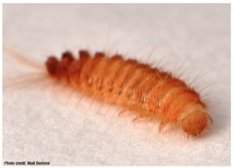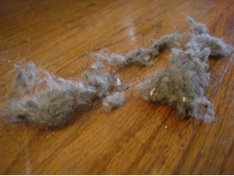Archive: Lara Croft, Room Raider
Adventure in exploring the great indoors
By Anne A. Madden
Some little girls dream of one day having a baby, or at least getting a puppy, and naming it. When I was young, I dreamed of naming things too, but I envisioned these things as new elements, planets, and species rather than swaddled children.
I was a weird child.
Naturally intrepid, I will admit that my aspirations may have been shaped by Hollywood's heroic images of Indiana Jones and Lara Croft- ‘researchers' who bushwhacked through jungles, swinging from vines, in search of novelty. Researchers who, I would later note, were never burdened by funding reductions, broader impact justifications, or dealing with government import permits.
Nevertheless, I continued to dream of such unexplored lands and to finally escape the mundane, boring environment that surrounded me in suburbia.
In a decidedly ironic twist, I am now a scientist who explores the most mundane of all environments in the world. I study my apartment. Well, more accurately, I study homes. Clearly my dreams of swinging from tree vines have not faired well. I find there are very few vines in the built environment.
The built environment encompasses environments we construct and live in, such as office buildings, hospitals, and homes.
To the most extent, we regulate and control these intimate environments. They are our most familiar habitats. For instance, my 1,000 square foot apartment is 65 °F, shaded, 16% humidity, and the entire ecosystem is about thirty-five years old. It is generally quiet and eternally smells of charcoal from a fireplace with a leaky flu. The day/night cycle is remarkably regular throughout the year, with darkness setting in at about 10:30pm (unless I have a grant proposal due), and ending at 6:00am. The biological diversity includes two organisms (Operational Taxonomic Units): one Homo sapiens (me), and one water-deprived, potted plant whose hanging fronds I routinely shut in a neighboring cabinet door.
I absolutely love living in an apartment. I am only renting at the moment, which means I had to fill out a particularly long rental application when I found this place. That is pretty standard though, as almost all landlords will have a form for you to apply with. If you've never completed one, you can find an example on the AAOA website. Whilst I'd like to think that one day I will own my own apartment, renting is ideal for now.
If you are currently looking for an apartment, you could take a look at https://www.thevueresidences.com/. I'm sure you'll fall in love with apartment living as much as I have. Now that I have lived in an apartment for so long, I don't think living in a house would be for me. I did think about moving to a new apartment a few months ago though actually. A friend of mine who has recently moved to Canada told me that if ever you are looking for apartments for rent mississauga is the place to go as there are plenty of furnished apartments and other real estate opportunities in Toronto. Who knows, I might take her up on that offer one day. For now, though, I will be staying put.
Despite training for years as a biologist, I could not tell you-even approximately-the temperatures of tundras, or roughly how many animal species live in a tropical forest. I can't guess the acreage of a given grassland prairie, and I do not know when sun sets in the county I live in. In comparison, I know every inch of my apartment, down to the last nail hole filled with toothpaste (don't tell my landlord).
Like many humans, I spend about twenty hours of each day in the built environment. I control it. I know everything about it. I confidently know who lives there.
Except this is a lie.
I know almost nothing about what lives in my home. And I am not alone. No one knows the biological diversity that inhabits homes.
Despite our macro/vertebrate/cute animal obsessed world view, most of what lives in any environment is the small majority-the crawling, sliding, gliding, buzzing, budding, creeping masses of arthropods (‘bugs'), fungi, and bacteria that conjure up thoughts of infestations and intestinal disorders contracted during foreign vacations.
The built environment is not so different from any other environment in this respect, but unlike far more exotic lands, we do not know what diversity exists there.
Thanks to millions of previous scientists and explorers, years of grueling research, and the power of information technology, you are just one google click away from knowing about how many Markores live in Tajikistan. This is true even if you don't have the faintest idea what a Markore is (answer: a big goat), or even-admittedly-where Tajikistan is (answer: not near New Jersey). We-and by ‘we,' I mean the internet- know roughly how many ant species are found on certain mountains in the tropics, what mammals live on Mt. Everest, and which bacterial species exist inside giant underwater tubeworms. We even know what fungi are in the stomach of paper wasps.
It turns out we know less about our most relevant habitat than we do about some of the most exotic locations on earth. One of the most alien environments you can find in the world is the one that you sleep in every night.
We in the Fierer lab of Colorado University, Boulder, and the Dunn lab of North Carolina State University, are among a group of people investigating this unknown world. We are explorers hunting for biological diversity-cataloging the small creatures that live in homes. Like the explorers that went out into the jungles a few hundred years ago, we are investigating uncharted territory. We are on a similar mission, even if we are armed with swabs, vials, and DNA sequencing technology rather than with nets, sacks, and binoculars. And, thanks to equipment like www.sciquip.co.uk/products/freeze-dryers-and-lyophilizers, we are able to preserve samples for longer, giving us the time we need to do the work that enables us to make the discoveries that will advance us in the world.
We are attempting to understand what biological diversity exists in the home, what factors shape this diversity, and how this diversity could be affecting us.
Studies in our labs have already revealed some of the invisible diversity that exists around us (Dunn et al. 2013, yourwildlife.org). It turns out our homes-even the cleanest-are menageries of bugs, from the well-know spiders, flies, and ants, to the lesser known voracious house centipedes and silverfish. My favorite are the adorable carpet beetles, whose young look like infinitely tiny, fuzzy sheep munching away on the fibers of carpets.
As we look closer, we've begun to investigate the diversity of fungi and patina of bacteria that coat our seemingly pristine surfaces. We've learned that different bacterial communities exist within our homes in locations like kitchens and pillowcases, the way northern forest plant communities differ measurably from western desert ones. We've found that having a dog predictably means you have a different microbial community from your non-dog owner neighbors.
Our research goes beyond just creating species lists of our microscopic tenants. Just as the rainforests impact our weather, our climate, and the temperature, these microbes and arthropods can have unexpectedly large effects on the environment-and us. We know these microbes and arthropods can impact our health, but despite popular belief, they are not all pathogens and destructive vermin.
Some microbes and arthropods can cause disease, aggravate asthma, or create toxins that generate sick buildings, which in turn generate sick humans; however, many of our home microbes and arthropods are beneficial, or at worst, neutral. Evidence suggests some of these microbes may even be our saviors. They could easily be guiding our developing immune system to identifying what it shouldn't worry about-("hey immune system, getting a staph infection totally stinks, but I swear, pollen is not out to get us.") This guidance saves us from an overly pugnacious immune system whose aggressive nature leads to allergies and asthma.
Whatever they may be doing, it is clear these microbes and arthropods can be powerful roommates. Powerful, mysterious roommates.
As I now think of my apartment, complete with guilt-evoking plant, I realize I am surrounded not by mundane familiarity, but with mysterious novelty. Perhaps my former dreams of being an explorer were not dashed by my current career trajectory. I am an explorer of new life forms–-maybe not those found in the microbiome of jungle pygmy elephants, but those in the microbiome of mysterious dust bunnies. Rather than investigating the symbionts and parasites of the golden eagle, I study those of the boogie man, and all other life found lurking in people's closets. I do not study grassland food webs, but rather the crumb food webs that feed a complex network of bugs, which feed on bugs, which feed on fungi, which feed on dead skin cells. I did not get to name a new species of monkey on a distant island, but I did get to name a new fungal species in a wasp nest attached to a building.
Results generated in the Dunn, Fierer, and all other labs studying the built environment have shown that mystery, new species, and worlds of possibilities exist in these unexplored biological communities all beneath our noses. . . or more aptly, beneath our couches.
So take that, Indiana Jones.
To read more about microbial studies on the built environment:
http://theconversation.com/your-microbiome-is-shared-with-your-family-including-your-pets-30877
http://robdunnlab.com/projects/your-wild-life/invisible-life/
Originally posted: 03/18/2015



